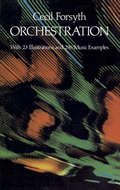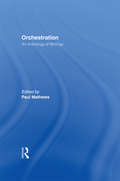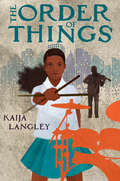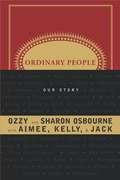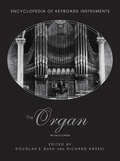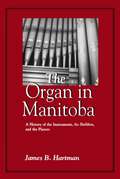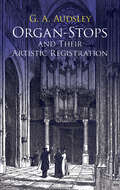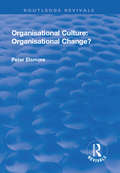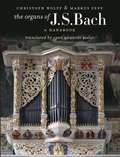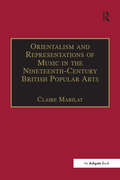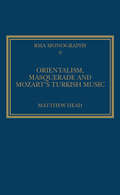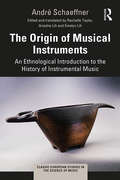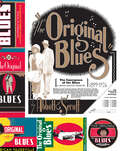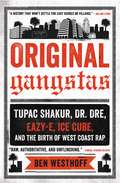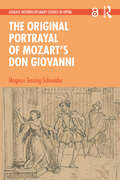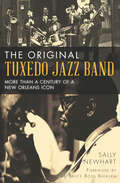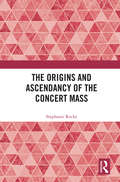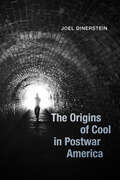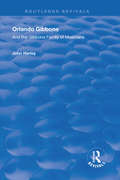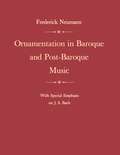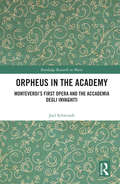- Table View
- List View
The Orchestral Music of Michael Tippett
by Thomas SchuttenhelmWith extracts from the composer's letters, writings, interviews and broadcasts, and supported by evidence from his sketchbooks and manuscripts, The Orchestral Music of Michael Tippett explores Tippett's intentions and argues that the experiences that triggered his creative impulses are integral to understanding his music. In his discussion of Tippett's creative process, Thomas Schuttenhelm attempts to recapture the circumstances under which Tippett's orchestral works were created, to document how his visionary aspirations were developed and sustained throughout the creative cycle, and to chart how conception was transmuted from idea through to performance. Analysing Tippett's orchestral works throughout his long career, from the Symphonic Movement of 1931 to his final masterpiece The Rose Lake in 1991–3, Schuttenhelm explores each work in detail to provide a comprehensive commentary on one of the most influential British composers of the twentieth century.
The Orchestral Revolution
by Emily I. DolanThe Orchestral Revolution explores the changing listening culture of the eighteenth and early nineteenth centuries. Delving into Enlightenment philosophy, the nature of instruments, compositional practices and reception history, this book describes the birth of a new form of attention to sonority and uncovers the intimate relationship between the development of modern musical aesthetics and the emergence of orchestration. By focusing upon Joseph Haydn's innovative strategies of orchestration and tracing their reception and influence, Emily Dolan shows that the consolidation of the modern orchestra radically altered how people listened to and thought about the expressive capacity of instruments. The orchestra transformed from a mere gathering of instruments into an ideal community full of diverse, nuanced and expressive characters. In addressing this key moment in the history of music, Dolan demonstrates the importance of the materiality of sound in the formation of the modern musical artwork.
Orchestration: Music Book Index (Dover Books on Music)
by Cecil Forsyth"For its time the most comprehensive treatment of the subject." -- New Grove Dictionary of Music and MusiciansBefore the 17th century, composers seldom indicated in their music whether the composition was to be performed by a particular combination of voices or instruments. Then in 1607 Monteverdi made a well-known suggestion for the orchestration of his opera Orfeo. And as the Baroque era unfolded, the concept of orchestrations began to evolve, achieving a notable clarity and the acceptance of a keyboard instrument as an integral part of the ensemble.Toward the middle of the 18th century, stylistic changes in instrumental music, e.g. styles that emphasized a single melodic line, directly affected methods of orchestration; while in the 19th century, orchestrations became an ever more vital factor in the composer's technique, a stylistic determinant that places a wealth of possibilities at his disposal. Finally, in the early 18th century, increasing awareness of the importance of internal balance, certain ideals of blended sound, and firmly established instrumental characteristics enabled orchestration to take its place as an academic discipline beside harmony and counterpoint.In this classic manual, a noted English composer describes 57 orchestral instruments (ca. 1914) tracing their origins, development, and status at the beginning of World War I. Not only are the history and evolution of each instrument fully discussed, the author also explores the techniques of each instrument, as well as players' impressions about what they must play. The result is an unparalleled insight into the inner working of an orchestra -- a vivid impression of what it is like to be a violinist, clarinetist, trombonist, or other orchestral player.While there have been numerous developments in instrumental technique on an individual basis since the book's first publication, most of what Forsyth says is still valid. Writing with wit, grace, and good sense, Forsyth created a formidably thorough, comprehensive, and informative text that has instructed and influenced generations of composers, conductors, musicians, and musicologists.
Orchestration: An Anthology of Writings
by Paul MathewsOrchestration: An Anthology of Writings is designed to be a primary or ancillary text for college-level music majors. Although there are several 'how to' textbooks aimed at this market, there is little available that traces the history of orchestration through the writings of composers themselves. By collecting writings from the ninenteenth century to today, Mathews illuminates how orchestration has grown and developed, as well as presenting a wide variety of theories that have been embraced by the leading practitioners in the field. The collection then traces the history of orchestration, beginning with Beethoven's Orchestra (with writings by Berlioz, Wagner, Gounod, Mahler, and others), the 19th century (Mahler, Gevaert, Strauss) the fin de siecle (on the edge of musical modernism; writings by Berlioz, Jadassohn, Delius, and Rimsky Korsakov), early modern (Busoni, Schoenberg, Stravinsky, Grainger, and others), and high modern (Carter, Feldman, Reich, Brant). Many of these pieces have never been translated into English before; some only appeared in small journals or the popular press and have never appeared in a book; and none have ever been collected in one place. The study of orchestration is a key part of all students of music theory and composition. Orchestration provides a much needed resource for these students, filling a gap in the literature.
The Order of Things
by Kaija LangleyA heart-rending novel-in-verse about a girl beginning to learn it is possible to go on even after a great loss.Eleven-year-old April Jackson loves playing the drums, almost as much as she loves her best friend, Zee, a violin prodigy. They both dream of becoming professional musicians one day. When Zee starts attending a new school that will nurture his talent, April decides it&’s time for her to pursue her dreams, too, and finally take drum lessons. She knows she isn&’t very good to start, but with Zee&’s support, she also knows someday she can be just as good as her hero, Sheila E., and travel all around the world with a pair of drumsticks in her hand.When the unthinkable happens and Zee suddenly passes away, April is crushed by grief. Without Zee, nothing is the way it&’s supposed to be. Zee's Dad isn't delivering the mail for his postal route like he should. April's Mom is suddenly dating someone new who is occupying too much space in their lives. And every time April tries to play the drums, all she can think about is Zee.April isn't sure how to move on from the awful feeling of being without Zee. Desperate to help Papa Zee, she decides to secretly deliver the mail he&’s been neglecting. But when on her route she discovers a classmate in trouble, she doesn&’t second guess what she knows is the right thing to do.
Ordinary People
by Family OsbourneIn their own words (and we all know how colorful those can be), the five members of the notorious Osbourne clan tell the amazing story of the first family of rock. OZZY talks about his first beer, his legendary career,and why he's the only sane member of the Osbourne family. SHARON explains the root of her shopaholic nature, the ups and downs of being married to Ozzy, and what it's like to battle cancer and host a talk show. AIMEE reveals why she opted out of MTV's The Osbournes, why she thinks her mother's in denial, and why her father destroyed himself with drugs. KELLY offers cutting thoughts on sibling relationships and growing up Osbourne as well as on life as a fledgling rock star. JACK shares stories about life without privacy ("What's privacy?") and his stint in rehab -- and claims he's the only sane one in the family. IF YOU THOUGHT YOU ALREADY KNEW THE OSBOURNES, THINK AGAIN!
The Organ: An Encyclopedia
by Richard KasselThe Encyclopedia of Organ includes articles on the organ family of instruments, including famous players, composers, instrument builders, the construction of the instruments, and related terminology. It is the first complete A-Z reference on this important family of keyboard instruments. The contributors include major scholars of music and musical instrument history from around the world.
The Organ in Manitoba: A History of the Instruments, the Builders, and the Players
by James B. HartmanPipe organs were once a central (and sometimes hotly debated) part of Manitoba's cultural life. The Organ in Manitoba portrays that history--the instruments, builders, players and critics--from the date of the earliest known installations to the 1990s, and includes information on musical organizations such as the Royal Canadian College of Organists. It documents over a century of evolution and changes, from concepts of tonal design to styles of musical commentary and tastes, and includes an inventory of installations and specifications for over 100 organs. Well-illustrated with photographs and excerpts from historical reviews and other documents, it will be of interest to musicians, teachers, and music, church, and cultural historians.
Organ-Stops and Their Artistic Registration (Dover Books On Music: Instruments)
by George Ashdown AudsleyThis 1921 classic by a renowned organ builder provides organists and all those interested in the instrument with a guide to its numerous stops, among them bassoon, bass tuba, cymbal, double trumpet, oboe, piccolo, viola da gamba, and xylophone. The text supplies various names of each stop in different languages, traces their origins, and describes their construction, tonal characteristics, and value in artistic combination and registration. A fascinating book about the "Monarch of all Instruments" for students, teachers, and professional musicians. A "must-have" for the organist's library. Introduction by Rollin Smith. 5 plates of illustrations.
Organisational Culture: Organisational Change? (Routledge Revivals)
by Peter ElsmoreThis title was first published in 2001. When organizational change occurs, members of the organization can feel insecure in the face of a seemingly uncertain future. This work investigates the links between organizational culture and organizational change by looking at two businesses that have been privatized - British Gas and British Telecom - and the processes surrounding the ways these organizations changed in the mid 1990s. It includes interviews with middle-ranking and senior officals, illustrating that anguish is experienced not only by those on the lower rungs of the corporate ladder.
Organising Music
by Nic Beech Charlotte GilmoreOrganisational theorists have become increasingly interested in the creative industries, where practices that are commonplace are of particular interest to organisations in other sectors as they look for new ways to enhance performance. Focusing on the music industry, this book sets up a unique dialogue between leading organisational theorists and music professionals. Part I explores links between organisation theory and the creative industries literature, concentrating on practices of organising and knowledge mobilisation, followed by an in-depth discussion of key theoretical concepts by subject experts. Part II provides a diverse range of 'tales from the field', including examples from classical orchestras, folk, indie and punk. The concluding chapter examines the shared dialogue to reveal what practice in the musical field can learn from organisational theory, and vice versa. This innovative book will interest graduate students and researchers in the fields of organisation studies, music management and the creative industries.
The Organs of J.S. Bach: A Handbook
by Lynn Edwards Butler Christoph Wolff Markus ZepfThe Organs of J. S. Bach is a comprehensive and fascinating guide to the organs encountered by Bach throughout Germany in his roles as organist, concert artist, examiner, teacher, and visitor. Newly revised and updated, the book's entries are listed alphabetically by geographical location, from Arnstadt to Zschortau, providing an easy-to-reference overview. Includes detailed organ-specific information: high-quality color photographs each instrument's history, its connection to Bach, and its disposition as Bach would have known it architectural histories of the churches housing the instruments identification of church organists Lynn Edwards Butler's graceful translation of Christoph Wolff and Markus Zepf's volume incorporates new research and many corrections and updates to the original German edition. Bibliographical references are updated to include English-language sources, and the translation includes an expanded essay by Christoph Wolff on Bach as organist, organ composer, and organ expert. The volume includes maps, a timeline of organ-related events, transcriptions of Bach's organ reports, a guide to examining organs attributed to Saxony's most famous organ builder Gottfried Silbermann, and biographical information on organ builders. Publication of this volume is supported by the American Bach Society.
Orientalism and Musical Mission: Palestine and the West
by Rachel Beckles WillsonOrientalism and Musical Mission presents a new way of understanding music's connections with imperialism, drawing on new archive sources and interviews and using the lens of 'mission'. Rachel Beckles Willson demonstrates how institutions such as churches, schools, radio stations and governments, influenced by missions from Europe and North America since the mid-nineteenth century, have consistently claimed that music provides a way of understanding and reforming Arab civilians in Palestine. Beckles Willson discusses the phenomenon not only in religious and developmental aid circles where it has had strong currency, but also in broader political contexts. Plotting a historical trajectory from the late Ottoman and British Mandate eras to the present time, the book sheds new light on relations between Europe, the USA and the Palestinians, and creates space for a neglected Palestinian music history.
Orientalism and Representations of Music in the Nineteenth-Century British Popular Arts (Music In Nineteenth-century Britain Ser.)
by Claire MabilatRepresentations of music were employed to create a wider 'Orient' on the pages, stages and walls of nineteenth-century Britain. This book explores issues of orientalism, otherness, gender and sexuality that arise in artistic British representations of non-European musicians during this time, by utilizing recent theories of orientalism, and the subsidiary (particularly aesthetic and literary) theories both on which these theories were based and on which they have been influential. The author uses this theoretical framework of orientalism as a form of othering in order to analyse primary source materials, and in conjunction with musicological, literary and art theories, thus explores ways in which ideas of the Other were transformed over time and between different genres and artists. Part I, The Musical Stage, discusses elements of the libretti of popular musical stage works in this period, and the occasionally contradictory ways in which 'racial' Others was represented through text and music; a particular focus is the depiction of 'Oriental' women and ideas of sexuality. Through examination of this collection of libretti, the ways in which the writers of these works filter and romanticize the changing intellectual ideas of this era are explored. Part II, Works of Fiction, is a close study of the works of Sir Henry Rider Haggard, using other examples of popular fiction by his contemporary writers as contextualizing material, with the primary concern being to investigate how music is utilized in popular fiction to represent Other non-Europeans and in the creation of orientalized gender constructions. Part III, Visual Culture, is an analysis of images of music and the 'Orient' in examples of British 'high art', illustration and photography, investigating how the musical Other was visualized.
Orientalism, Masquerade and Mozart's Turkish Music
by Matthew HeadMatthew Head explores the cultural meanings of Mozart's Turkish music in the composer's 18th-century context, in subsequent discourses of Mozart's significance for 'Western' culture, and in today's (not entirely) post-colonial world. Unpacking the ideological content of Mozart's numerous representations of Turkey and Turkish music, Head locates the composer's exoticisms in shifting power relations between the Austrian and Ottoman Empires, and in an emerging orientalist project. At the same time, Head complicates a presentist post-colonial critique by exploring commercial stimuli to Mozart's turquerie, and by embedding the composer's orientalism in practices of self-disguise epitomised by masquerade and carnival. In this context, Mozart's Turkish music offered fleeting liberation from official and proscribed identities of the bourgeois Enlightenment.
The Origin of Musical Instruments: An Ethnological Introduction to the History of Instrumental Music (Classic European Studies in the Science of Music)
by André SchaeffnerThe work of French musicologist, ethnologist and critic Andre Schaeffner (1895– 1980) grew out of his first organological studies of the history of Western classical instruments in the late 1920s and encapsulated in his wide-ranging Origine des instruments de musique, which captures his studies in Paris between 1931 and 1936. Almost 80 years after its first publication, the scientific relevance and influence of Schaeffner’s primary hypothesis—that the origins of music can be traced to the human body through gesture, dance and the movements in the use of musical instruments and their ancestor tools—remains pertinent in fields which have returned to informed speculative and empirical research on the origins of music. This first English edition is accompanied by editorial footnotes and introductory texts, and the influence of Schaeffner’s thought on several generations of musicologists makes his work an essential piece of reading for ethnomusicologists, music psychologists, organologists and musicologists interested in the history of their field.
The Original Blues: The Emergence of the Blues in African American Vaudeville (American Made Music Series)
by Lynn Abbott Doug SeroffBlues Book of the Year —Living BluesAssociation of Recorded Sound Collections Awards for Excellence Best Historical Research in Recorded Blues, Gospel, Soul, or R&B–Certificate of Merit (2018)2023 Blues Hall of Fame Inductee - Classic of Blues Literature categoryWith this volume, Lynn Abbott and Doug Seroff complete their groundbreaking trilogy on the development of African American popular music. Fortified by decades of research, the authors bring to life the performers, entrepreneurs, critics, venues, and institutions that were most crucial to the emergence of the blues in black southern vaudeville theaters; the shadowy prehistory and early development of the blues is illuminated, detailed, and given substance.At the end of the nineteenth century, vaudeville began to replace minstrelsy as America’s favorite form of stage entertainment. Segregation necessitated the creation of discrete African American vaudeville theaters. When these venues first gained popularity, ragtime coon songs were the standard fare. Insular black southern theaters provided a safe haven, where coon songs underwent rehabilitation and blues songs suitable for the professional stage were formulated. The process was energized by dynamic interaction between the performers and their racially-exclusive audience.The first blues star of black vaudeville was Butler “String Beans” May, a blackface comedian from Montgomery, Alabama. Before his bizarre, senseless death in 1917, String Beans was recognized as the “blues master piano player of the world.” His musical legacy, elusive and previously unacknowledged, is preserved in the repertoire of country blues singer-guitarists and pianists of the race recording era.While male blues singers remained tethered to the role of blackface comedian, female “coon shouters” acquired a more dignified aura in the emergent persona of the “blues queen.” Ma Rainey, Bessie Smith, and most of their contemporaries came through this portal; while others, such as forgotten blues heroine Ora Criswell and her protégé Trixie Smith, ingeniously reconfigured the blackface mask for their own subversive purposes.In 1921 black vaudeville activity was effectively nationalized by the Theater Owners Booking Association (T.O.B.A.). In collaboration with the emergent race record industry, T.O.B.A. theaters featured touring companies headed by blues queens with records to sell. By this time the blues had moved beyond the confines of entertainment for an exclusively black audience. Small-time black vaudeville became something it had never been before—a gateway to big-time white vaudeville circuits, burlesque wheels, and fancy metropolitan cabarets. While the 1920s was the most glamorous and remunerative period of vaudeville blues, the prior decade was arguably even more creative, having witnessed the emergence, popularization, and early development of the original blues on the African American vaudeville stage.
Original Gangstas: The Untold Story of Dr. Dre, Eazy-E, Ice Cube, Tupac Shakur, and the Birth of West Coast Rap
by Ben Westhoff"Raw, authoritative, and unflinching ... An elaborately detailed, darkly surprising, definitive history of the LA gangsta rap era."---Kirkus, starred reviewA monumental, revealing narrative history about the legendary group of artists at the forefront of West Coast hip-hop: Eazy-E, Dr. Dre, Ice Cube, Snoop Dogg, and Tupac Shakur.Amid rising gang violence, the crack epidemic, and police brutality, a group of unlikely voices cut through the chaos of late 1980s Los Angeles: N.W.A. Led by a drug dealer, a glammed-up producer, and a high school kid, N.W.A gave voice to disenfranchised African Americans across the country. And they quickly redefined pop culture across the world. Their names remain as popular as ever--Eazy-E, Dr. Dre, and Ice Cube. Dre soon joined forces with Suge Knight to create the combustible Death Row Records, which in turn transformed Snoop Dogg and Tupac Shakur into superstars.Ben Westhoff explores how this group of artists shifted the balance of hip-hop from New York to Los Angeles. He shows how N.W.A.'s shocking success lead to rivalries between members, record labels, and eventually a war between East Coast and West Coast factions. In the process, hip-hop burst into mainstream America at a time of immense social change, and became the most dominant musical movement of the last thirty years. At gangsta rap's peak, two of its biggest names--Tupac and Biggie Smalls--were murdered, leaving the surviving artists to forge peace before the genre annihilated itself. Featuring extensive investigative reporting, interviews with the principal players, and dozens of never-before-told stories, Original Gangstas is a groundbreaking addition to the history of popular music.
The Original Portrayal of Mozart’s Don Giovanni (Ashgate Interdisciplinary Studies in Opera)
by Magnus Tessing SchneiderThe Original Portrayal of Mozart’s Don Giovanni offers an original reading of Mozart’s and Da Ponte’s opera Don Giovanni, using as a lens the portrayal of the title role by its creator, the baritone Luigi Bassi (1766–1825). Although Bassi was coached in the role by the composer himself, his portrayal has never been studied in depth before, and this book presents a large number of new sources (first- and second-hand accounts), which allows us to reconstruct his performance scene by scene. The book confronts Bassi’s portrayal with a study of the opera’s early German reception and performance history, demonstrating how Don Giovanni as we know it today was not only created by Mozart, Da Ponte and Luigi Bassi but also by the early German adapters, translators, critics and performers who turned the title character into the arrogant and violent villain we still encounter in most of today’s stage productions. Incorporating discussion of dramaturgical thinking of the late Enlightenment and the difficult moral problems that the opera raises, this is an important study for scholars and researchers from opera studies, theatre and performance studies, music history as well as conductors, directors and singers.
The Original Tuxedo Jazz Band: More Than a Century of a New Orleans Icon (Music Ser.)
by Sally NewhartA lively look at the long career of these legendary musicians, from a Storyville dance hall to the White House and beyond. In 1910, the Tuxedo Jazz Band played its first show at the Tuxedo Dance Hall in Storyville under Oscar Celestin. The popular ensemble would go on to play all over New Orleans, as well as across the South and the nation—and in 1953, it became the first jazz band to play the White House. The band has punctuated jazz history and produced some of the most memorable musicians of the past century: Bob French, Albert French, William Ridgley, Octave Crosby, Louis Armstrong, and more. Author Sally Newhart has written a definitive and captivating history of the band from inception to present, including oral histories, archival photos, a discography, and a previously unpublished complete list of members since 1910.
The Origins and Ascendancy of the Concert Mass
by Stephanie RockeThe mass is an extraordinary musical form. Whereas other Western art music genres from medieval times have fallen out of favour, the mass has not merely survived but flourished. A variety of historical forces within religious, secular, and musical arenas saw the mass expand well beyond its origins as a cycle of medieval chants, become concertised and ultimately bifurcate. Even as Western societies moved away from their Christian origins to become the religiously plural and politically secular societies of today, and the Church itself moved in favour of congregational singing, composers continued to compose masses. By the early twentieth century two forms of mass existed: the liturgical mass composed for church services, and the concert mass composed for secular venues. Spanning two millennia, The Origins and Ascendancy of the Concert Mass outlines the origins and meanings of the liturgical texts, defines the concert mass, explains how and why the split occurred, and provides examples that demonstrate composers’ gradual appropriation of the genre as a vehicle for personal expression on serious issues. By the end of the twentieth century the concert mass had become a repository for an eclectic range of theological and political ideas.
The Origins of Cool in Postwar America
by Joel DinersteinAn “entertaining” study of the enduring concept of coolness, and the mix of cultures and historical events that shaped it (The New York Times).Cool. It was a new word and a new way to be, and in a single generation, it became the supreme compliment of American culture. The Origins of Cool in Postwar America uncovers the hidden history of this concept and its new set of codes that came to define a global attitude and style. As Joel Dinerstein reveals, cool began as a stylish defiance of racism, a challenge to suppressed sexuality, a philosophy of individual rebellion, and a youthful search for social change.Through portraits of iconic figures, he illuminates the cultural connections and artistic innovations among Lester Young, Humphrey Bogart, Robert Mitchum, Billie Holiday, Frank Sinatra, Jack Kerouac, Albert Camus, Marlon Brando, James Dean, and others. We eavesdrop on conversations among Jean-Paul Sartre, Simone de Beauvoir, and Miles Davis, and on a forgotten debate between Lorraine Hansberry and Norman Mailer over the “white Negro” and black cool. We come to understand how the cool worlds of Beat writers and Method actors emerged from the intersections of film noir, jazz, and existentialism. Out of this mix, Dinerstein sketches nuanced definitions of cool that unite concepts from African-American and Euro-American culture: the stylish stoicism of the ethical rebel loner; the relaxed intensity of the improvising jazz musician; the effortless physical grace of the Method actor. To be cool is not to be hip and to be hot is definitely not to be cool.“Eminently readable. Much more than just a history of cool, this book is a studied examination of the very real, often problematic social issues that popular culture responds to.” —Publishers Weekly (starred review)“The kind of book that makes learning enjoyable.” —The Wall Street Journal“Superb.” —Times Higher Education
Orlando Gibbons and the Gibbons Family of Musicians (Routledge Revivals)
by John HarleyFirst published in 1999, this volume is the first full-length study to deal with the life and music of Orlando Gibbons since E.H. Fellowes’s short book, originally published in 1923. John Harley investigates in detail the family and musical background from which Orlando Gibbons emerged, and gives a fascinating account of the activities of his father, William Gibbons, as a wait in Oxford and Cambridge. He traces, too, the activities of Orlando’s brothers – Edward, who was the master of the choristers at King’s College, Cambridge and later at Exeter Cathedral; Ferdinando, who may have taken over from his father as head of the Cambridge waits, and who became a wait in Lincoln; and Ellis, who contributed two madrigals to Thomas Morley’s collection of 1601, The Triumphs of Oriana. Attention naturally focuses principally on Orlando Gibbons. A full record is given of his remarkably youthful appointment as an organist of the Chapel Royal (he was probably less than twenty at the time) and of his life at court. His additional appointments as one of Prince Charles’s musicians and as organist of Westminster Abbey are also described, as is his sudden and premature death in his early forties. Gibbons’s music is carefully examined in a series of chapters dealing with his pieces for keyboard and for viols, his songs, his full and verse anthems, and his works for the Anglican liturgy. His development as a composer within these genres is followed, and the character of particular pieces is considered. John Harley concludes that whereas, at one time, Gibbons ‘tended to be admired as a successor to Tallis and Byrd, working in a style not essentially different from theirs’, it is now ‘easier to view him as a pioneer, whose work was cut short by his untimely death’. Orlando Gibbons’s son Christopher was only a child when his father died, but he became one of the foremost composers and keyboard players of his generation, writing and performing chamber works and music for the stage during the Commonwealth. Following the Restoration of King Charles II, Christopher Gibbons gained his father’s former posts at the Chapel Royal and Westminster Abbey, for which establishments he wrote a number of anthems. His importance is recognized by the inclusion of a long chapter on his life and works.
Ornamentation in Baroque and Post-Baroque Music, with Special Emphasis on J.S. Bach
by Frederick NeumannOrnaments play an enormous role in the music of the seventeenth and eighteenth centuries, and ambiguities in their notation (as well as their frequent omission in the score) have left doubt as to how composers intended them to be interpreted. Frederick Neumann, himself a violinist and conductor, questions the validity of the rigid principles applied to their performance. In this controversial work, available for the first time in paperback, he argues that strict constraints are inconsistent with the freedom enjoyed by musicians of the period.The author takes an entirely new look at ornamentation, and particularly that of J. S. Bach. He draws on extensive research in England, France, Germany, Italy, and the United States to show that prevailing interpretations are based on inadequate evidence. These restrictive interpretations have been far-reaching in their effect on style. By questioning them, this work continues to stimulate a reorientation in our understandiing of Baroque and post-Baroque music.
Orpheus in the Academy: Monteverdi's First Opera and the Accademia degli Invaghiti (Routledge Research in Music)
by Joel SchwindtThis book introduces a new perspective on Claudio Monteverdi's Orfeo (1607), a work widely regarded as the 'first great opera', by exploring the influence of the Mantuan Accademia deglia Invaghiti, the group which hosted the opera’s performance, and to which the libretto author, Alessandro Striggio the Younger, belonged. Arguing that the Invaghiti played a key role in shaping the development of Orfeo, the author explores the philosophical underpinnings of the Invaghiti and Italian academies of the era. Drawing on new primary sources, he shows how the Invaghiti’s ideas about literature, dramaturgy, music, gender, and aesthetics were engaged and contested in the creation and staging of Orfeo. Relevant to researchers of music history, performance, and Renaissance and Baroque Italy, this study sheds new light on Monteverdi’s opera as an intellectual and philosophical work.

